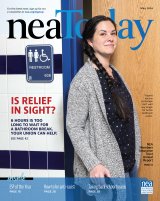Close-Up
Indigenous History Gets a Boost
The Ojibwe, Dakota, and other Indigenous tribal nations have called Minnesota home for thousands of years, and residents have experienced their presence and impact for centuries.
Still, many students have minimal or inaccurate knowledge of Native history.
“Indigenous people are still here,” says Tanis Henderson, a White Earth Nation descendant and counselor at Minnesota’s Grand Rapids High School. “Educators are ready and willing to learn more about Indigenous communities,” she adds.
To close students’ knowledge gap, a state law passed in 2023 requires K–12 educators to receive training about Native American history and culture in order to renew their teaching licenses.
Until now, the history and culture of Native students has not been represented in the general curriculum, says Indigenous educator Theresa Ziebarth-Moritz.
She has been working with the Minnesota Professional Educator Licensing and Standards Board to develop an outline and framework covering what students and teachers need to know about Indigenous history and culture in the state.
She wants teachers to understand the concept of sovereignty—the ability of Native tribes to govern, enforce laws, and protect and enhance the health, safety, and welfare of tribal citizens within tribal territory. Recognizing past traumas and the complete history of Native Americans is also an important part of this learning, she explains.
“Teachers need to know about the boarding school trauma and its generational effects,” Ziebarth-Moritz says. The training’s should focus on presenting an accurate portrayal of Native students’ identities and history, she adds.
When Ziebarth-Moritz was a student, she recalls not feeling comfortable sharing the dehumanization and brutalization she knew her relatives experienced at Native American boarding schools.
She wants a different reality for Native students today.
—Aniya Greene-Santos and Brenda Álvarez
HONOR NATIVE PEOPLE IN YOUR CLASSROOM
One way to recognize Indigenous people is through a Native land acknowledgment, a formal statement that recognizes the relationship that exists between Indigenous people and their traditional territories. They often start like this:
“We begin by acknowledging that we gather today on the ancestral lands of [name of local tribe or tribes] who were removed unjustly, and that we in this community are the beneficiaries of that removal. We honor them as we live, work, and study here at [your school or organization’s name].
This is a great way for students to learn about the Indigenous people who originally inhabited the land.
For an in-depth guide to land acknowledgments, visit nea.org/LandAcknowledgment.
Explore lessons, activities, and resources related to Native People at nea.org/IndigenousCultures.

Member Spotlight
Instilling Pride in Native Cultures
Leslie Montemayor
Indian Education Coordinator
Okemah, Oklahoma
“Most Americans are unaware that a Native American was a heartbeat away from serving as the U.S. president; that Native Americans were not granted U.S. citizenship until 1924; and that federal law did not allow tribes to teach their Native languages until 1972. What many people do know—or think they know—is often based on stereotypes and fallacies.
Even worse, our Native American students, from past to present, have been deprived of feeling pride in their rich culture. Native history is packed with valuable contributions and knowledge. Long before anyone else arrived to these lands, many tribes modeled how to form a democracy rooted in a desire for peace. Most knew how to cultivate crops that are still essential today. And Native “code talkers” helped the U.S. win World War II by using their languages to develop secret codes.
As the Indian Education Coordinator for 77 counties in Oklahoma and a Native American myself, I help teachers facilitate lessons about Native history and traditions, and teach students about the contributions of Oklahoma tribes. All American school children need to learn the truth of Native American history.”
Quick Takes
Quote byAdonis Schurmann , Texas

Quote byJulie Nietling , Michigan
Quote byKari L.
Quote byJim Z.
Quote byJanet Weil-True , Missouri
Quote bySharon Dolan , Washington
Quote byDave A.
Learn More
Get more from









